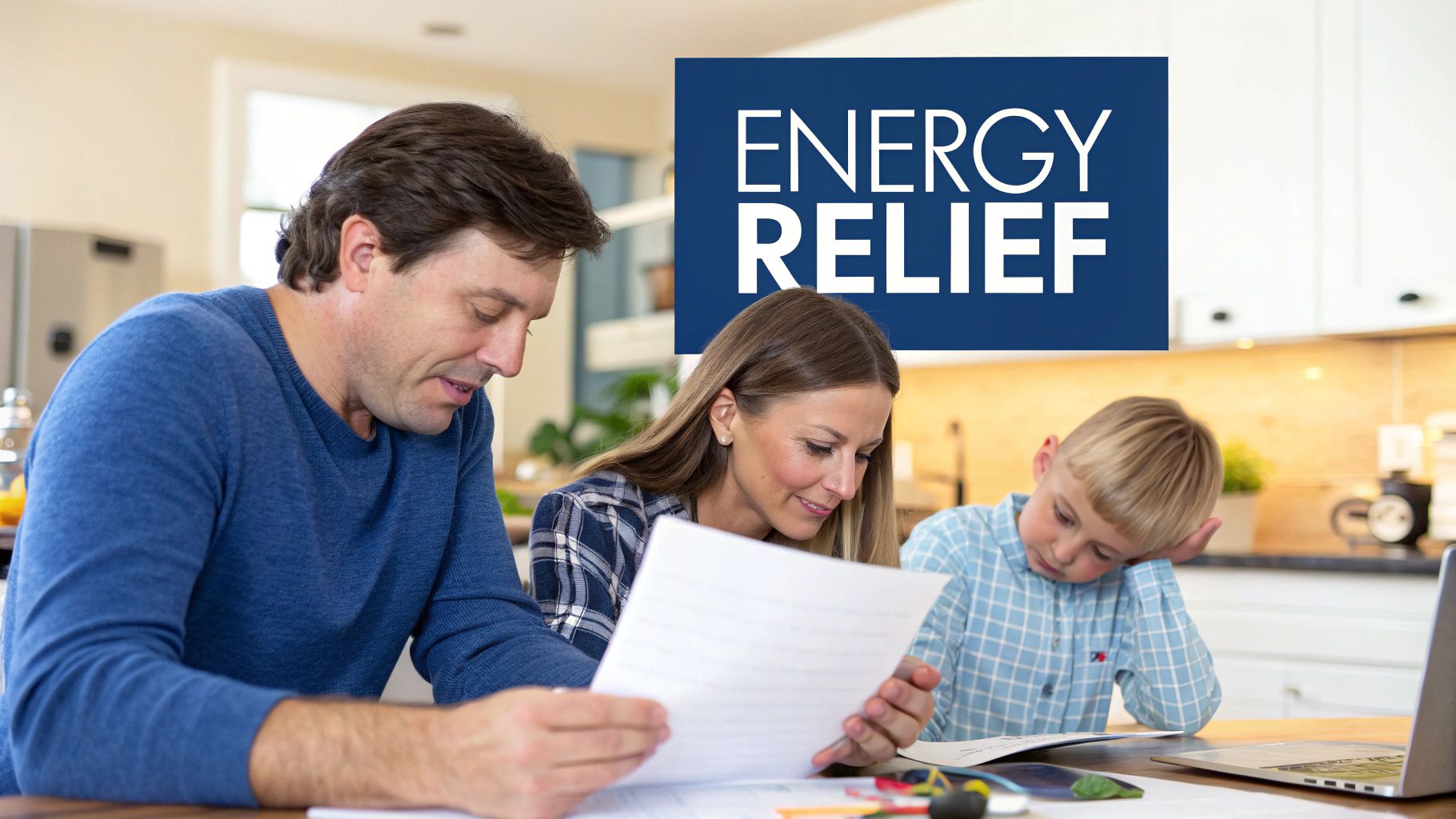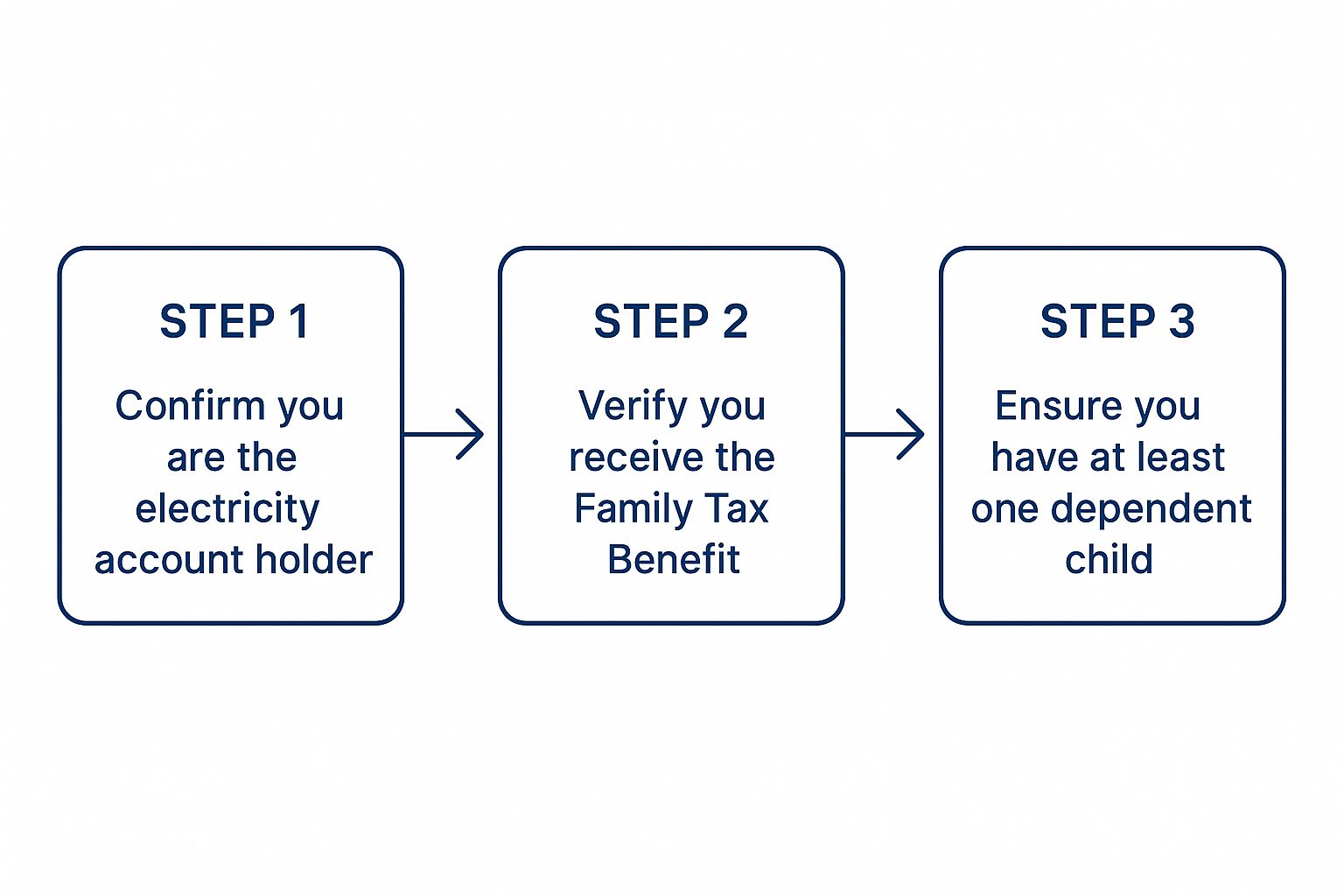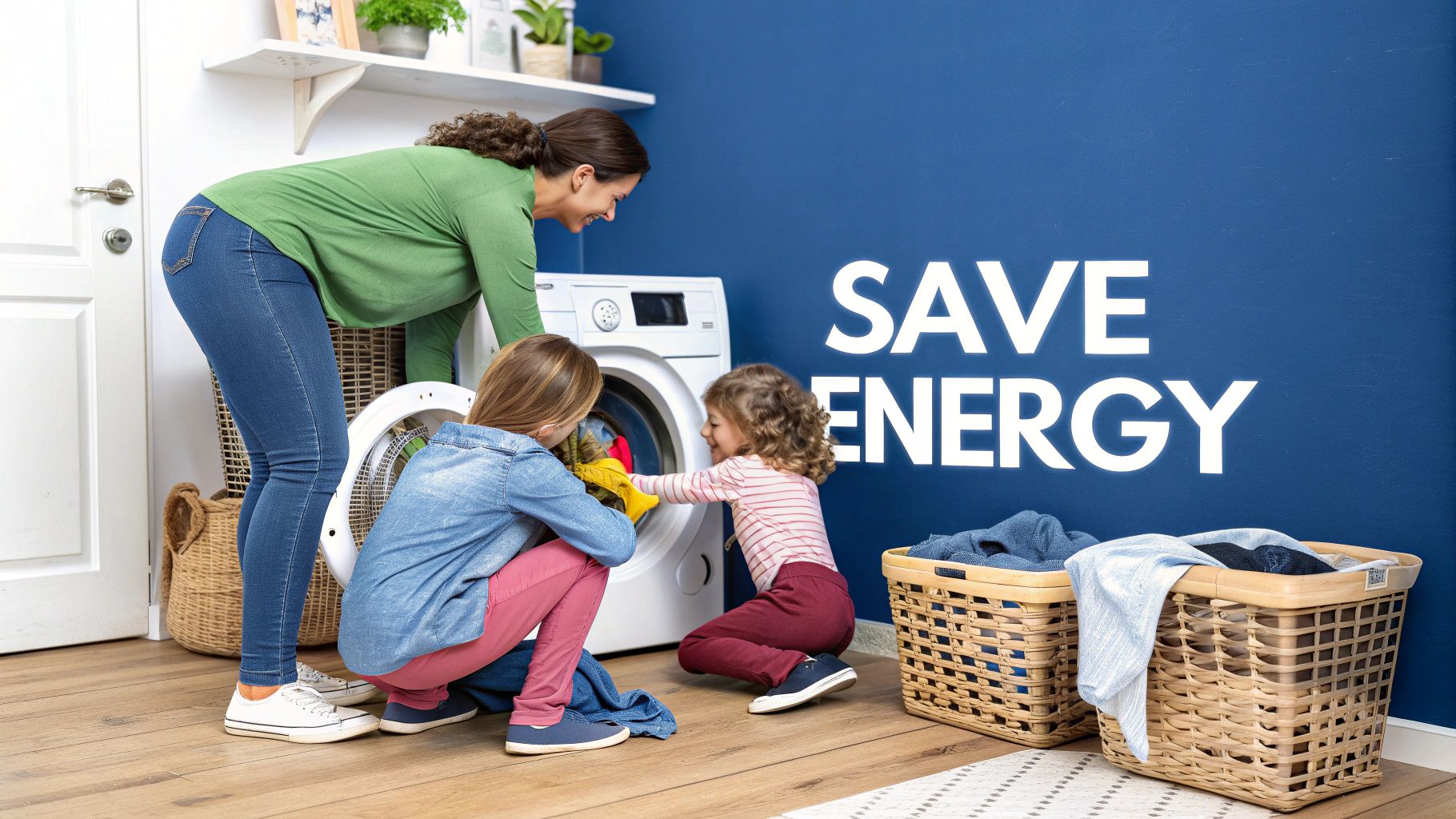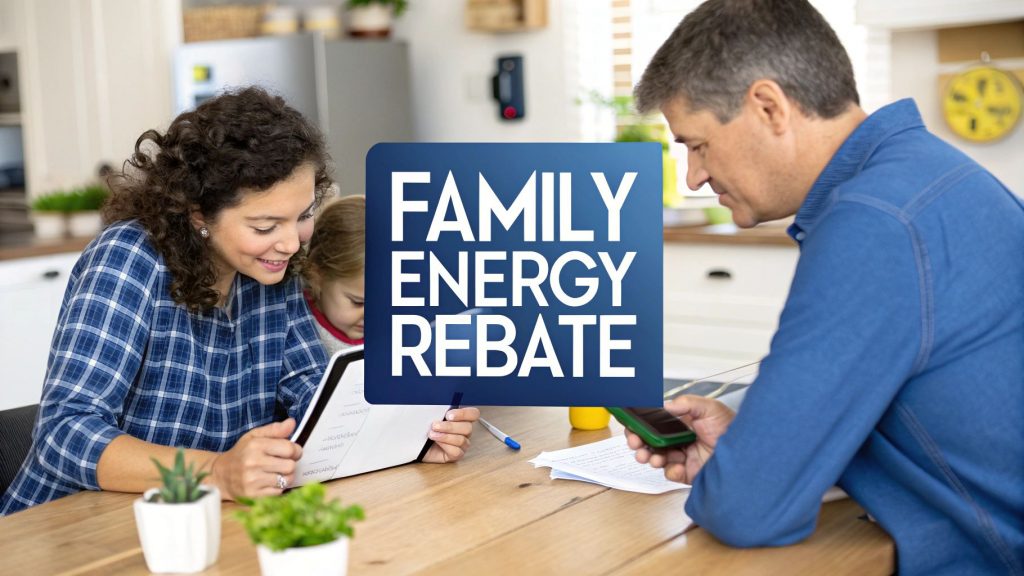Family Energy Rebate NSW a How-To Guide
If you're keeping a close eye on your household budget, rising electricity costs can feel like a constant pressure. The NSW Government's Family Energy Rebate is one of the key support measures designed to take some of that weight off your shoulders.
It’s an annual credit specifically for NSW families with dependent children, helping to bring down those quarterly power bills.
Making Sense of the NSW Family Energy Rebate

So, what is it exactly? Think of the Family Energy Rebate as a helping hand applied directly to your electricity account. It’s not a cash payment. Instead, it’s a credit that reduces the amount you owe your energy retailer.
To get it, you need to be receiving the Commonwealth Family Tax Benefit (FTB). This is the main eligibility check that confirms you're a household with dependent children. It's important to know that unlike some other national programs that are applied automatically, this one requires you to put in an application each financial year.
How Much of a Difference Does It Make?
The whole point is to give families some breathing room. Once your application gets the green light, the credit lands on your electricity account, automatically lowering your next bill. You don't have to do anything else; the savings just show up.
And the impact isn't trivial. These programs make a real, measurable difference for thousands of households across the state.
According to the latest government data, NSW energy rebates cut electricity bills for eligible households by an average of 15.4%. For many families, that's a significant saving that frees up cash for other essentials.
The scale of this support is massive. In the 2023-24 period, NSW Energy Social Programs provided over $324 million in assistance to households. You can see the full breakdown in the NSW Energy Social Programs Annual Report 2023–24. It shows just how vital these rebates are in making energy more affordable.
So, Are You Eligible for the Rebate?
Figuring out if you qualify for government support can feel like navigating a maze, but the rules for the Family Energy Rebate are refreshingly straightforward. It really just boils down to a few key checks that connect your family situation to your energy bill.
At its core, this rebate is designed for NSW families with dependent kids. The main way the government verifies this is by looking at your Commonwealth Family Tax Benefit (FTB). If you're receiving FTB payments, you're almost certainly on the right track.
The Three Big Checks
Before you jump into the application, it’s worth doing a quick mental run-through. The absolute must-have is that you received an FTB payment from Services Australia for the previous financial year. That payment also needs to have been for at least one dependent child.
Another crucial detail—and one that trips a lot of people up—is that you must be the electricity account holder. Your name has to be on the bill for your main home in NSW. This is a common hurdle, especially if you’re in a share house or have recently separated. If the bill is in a partner’s or flatmate’s name, you'll need to ring your energy company and get your name added before applying.
This little infographic breaks it down nicely.

As you can see, the Family Tax Benefit is the linchpin connecting everything together.
Family Energy Rebate Eligibility Checklist
Still not 100% sure? Use this quick guide to see if your household meets the core requirements for the rebate.
| Requirement | What This Means for You | Key Action |
|---|---|---|
| NSW Resident | Your primary place of residence must be in New South Wales. | Check that your address on your electricity bill and with Services Australia is your current NSW home. |
| Electricity Account Holder | The electricity bill for your home must be in your name. | Grab a recent bill. Is your name on it? If not, contact your retailer to have it added or transferred. |
| Family Tax Benefit (FTB) | You must have been assessed and deemed eligible for the FTB for the last financial year. This must include one dependent child. | Log in to your Centrelink account via myGov to confirm your FTB assessment details for the relevant financial year. |
This checklist covers the main pillars of eligibility. If you can tick off all three, you're in a great position to apply.
Real-World Scenarios (and How to Handle Them)
Life happens, and circumstances change. For example, if you've recently separated and the electricity bill was in your ex-partner's name, you have to get that updated with your provider first. Simple as that. Only the person whose name is on the bill can lodge a successful application.
The single biggest takeaway is this: make sure your details with your energy retailer and Services Australia are perfectly aligned. A mismatch between the name on your power bill and the name registered for your FTB is the number one reason applications get rejected.
Likewise, if your FTB circumstances changed during the year, don't stress. What matters is that you were ultimately assessed as eligible for the FTB for the financial year you're applying in. Get these three things lined up—NSW residency, your name on the bill, and your FTB sorted—and you can move forward with confidence.
How to Apply for the Rebate Online

Tackling a government form can feel like a real chore, but applying for the Family Energy Rebate NSW is more straightforward than you might think. The whole thing is handled online through the Service NSW website, and it’s actually designed to be pretty quick.
A little bit of prep work goes a long way here. Getting your documents ready before you even open the application page will turn a potentially frustrating task into a smooth, ten-minute job. Trust me, it stops you from having to hit pause and rummage through your files halfway through.
Getting Your Ducks in a Row
To make the application totally seamless, it pays to gather these essential items first. You simply won't be able to complete the form without them.
- Your MyServiceNSW Account details to log in.
- Your Centrelink Customer Reference Number (CRN). This is crucial for verifying your Family Tax Benefit eligibility.
- Your most recent electricity bill. It has a few key details you'll need to pull out.
- Your basic contact information, like a valid email and phone number.
Having these on hand means you can power through the form in one go without any annoying interruptions.
Finding That Tricky NMI Number
One detail that often trips people up is the National Meter Identifier, or NMI. This is a unique 10 or 11-digit number that pinpoints your specific electricity connection. It's not the same thing as your customer account number.
You’ll find it on the first or second page of your electricity bill, usually tucked away in a section labelled "Meter Details" or "Your Supply Details." Locating it beforehand is a pro tip that saves a lot of head-scratching during the application.
Pro Tip: The NMI always starts with the letter 'N'. If you're looking at a number that doesn't, it’s almost certainly your account number. Keep scanning the bill until you find the right one.
Once you have everything ready, you can get started. Just log into your MyServiceNSW account and search for the "Family Energy Rebate" form. The system will then walk you through entering your personal info, your CRN, and the details from your energy bill—including that all-important NMI.
After you hit submit, Service NSW gets to work processing your application. This can take a few weeks, but you can usually track its progress through your account. Once it’s approved, the rebate is sent straight to your electricity retailer, who will apply it as a credit to your next bill. Easy as that.
What If You're in an Embedded Network?
What happens if you don’t get a bill directly from a big retailer like Origin or AGL? This is a common setup for people living in apartment complexes, retirement villages, or strata schemes. In these cases, you're usually part of an embedded network.
An embedded network is just a fancy way of saying the building owner or manager buys electricity in bulk and then sells it on to residents. While it can make things simpler, it does mean your name isn't on a direct account with a retailer, so you can't apply for the Family Energy Rebate the standard way.
How to Apply When You Live in an Embedded Network
The good news is you are still absolutely eligible for the rebate. The process is just a little different, and you get paid differently too. Instead of a credit appearing on your power bill, the rebate usually lands directly in your nominated bank account.
To get the ball rolling, you’ll need to track down the specific form for embedded network customers on the Service NSW website. Make sure you have these details handy:
- Proof that you’re eligible (like your Centrelink CRN).
- A copy of a recent electricity bill or invoice from your building manager.
- Your bank account details for the direct deposit.
This process makes sure you get the same support as any other eligible family. It’s a fair system that works with any electricity retailer arrangement, which is great for ensuring everyone can access the support they're entitled to.
Keep in mind, if you're already receiving another NSW electricity rebate (like the Low Income Household Rebate), there's a good chance you'll be assessed and paid automatically. The system is set up to catch most eligible households without you needing to lodge more paperwork.
Don’t let your living situation stop you from claiming what’s yours. Households in these networks just need to follow a slightly different path, as outlined in the government's National Energy Bill Relief guidelines.
Saving More Money on Your Energy Bills

The Family Energy Rebate is a great help, but it works best when you pair it with smart, long-term savings habits. The real wins come when you move past just flicking off lights and start tackling the hidden energy drains dotted around most family homes.
For instance, modern gaming consoles, smart TVs, and streaming devices are notorious for chewing through power even on standby. It’s a classic ‘vampire power’ problem. Switching them off at the wall when you’re done might feel small, but those savings really add up over a year.
It’s the same story in the laundry. Simple changes like using cold water for most washes and only running the machine when it’s full can make a real dent in both your power and water bills.
Combine Rebates for Bigger Savings
Don't just stop at one rebate. The NSW Government has a whole suite of support programs, and there's a good chance you're eligible for more than you realise. Stacking these savings is one of the smartest moves you can make.
You should definitely check if you qualify for these:
- Low Income Household Rebate: This gives you a credit if you hold an eligible concession card.
- Gas Rebate: If you use natural gas for your heating, hot water, or cooking, a separate rebate can help take the edge off that bill.
- Seniors Energy Rebate: This one is available for self-funded retirees who have a Commonwealth Seniors Health Card.
By looking into these additional supports, you create a much stronger financial cushion against rising energy costs. It’s about using every available tool to your advantage.
Curious about how much you could really save by making these changes? A dedicated energy savings calculator can give you a pretty good estimate of the impact on your household bills.
Got Questions About the Rebate?
Even with a straightforward guide, it’s natural for a few specific questions to pop up when you’re dealing with government rebates. Let's run through some of the most common ones we hear about the Family Energy Rebate NSW to clear things up.
One of the biggest worries is getting that dreaded rejection email. If it happens, don't panic. More often than not, it's down to a simple mismatch between the name on your electricity bill and the name registered for your Family Tax Benefit (FTB) with Services Australia. Before you do anything else, pull out both documents and check that the names and addresses align perfectly.
Another common hiccup is applying before your FTB has actually been finalised for that financial year. If you're sure you tick all the boxes but still got knocked back, the best first step is to call Service NSW directly and ask them to explain the decision.
Can You Backdate a Claim for Previous Years?
This one is a firm no. Applications for the Family Energy Rebate are strictly tied to the current financial year and have a hard deadline, which usually lands in mid-June. You can't go back and apply for a rebate you missed out on last year.
The key is to be ready. As soon as you get that Family Tax Benefit finalisation letter from Services Australia, it’s the perfect time to get your application in and avoid leaving money on the table.
How Is This Different from the National Relief Payment?
It’s easy to get the different support payments mixed up. The Family Energy Rebate is a specific NSW Government program just for households that get the Family Tax Benefit.
On the other hand, the National Energy Bill Relief is a completely separate initiative from the federal government with broader eligibility. While it's possible to receive both if you qualify, they are two distinct programs with their own rules. The national relief is often applied to your bill automatically, whereas the Family Energy Rebate NSW always needs you to lodge an application yourself.
For more detailed answers to other common queries, you can also check our extensive help and FAQs section.
Ready to take control of your energy costs and build a more resilient home? At HighFlow Connect, we help Australian households get more from their rooftop solar with our intelligent Virtual Power Plant. Learn how you can earn extra income from your solar and battery system at https://highflowconnect.com.au.


